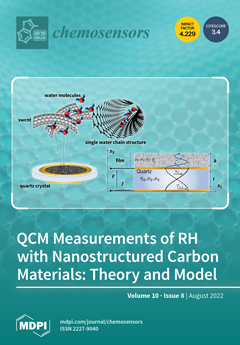As a new form of energy, hydrogen (H
2) has clean and green features, and the detection of H
2 has been a hot topic in recent years. However, the lack of suitable laser sources and the weak optical absorption of H
[...] Read more.
As a new form of energy, hydrogen (H
2) has clean and green features, and the detection of H
2 has been a hot topic in recent years. However, the lack of suitable laser sources and the weak optical absorption of H
2 limit the research concerning its detection. In this study, a continuous-wave distributed feedback (CW-DFB) diode laser was employed for sensing H
2. Tunable diode laser absorption spectroscopy (TDLAS) was adopted as the detection technique. The strongest H
2 absorption line, located at 4712.90 cm
−1 (2121.83 nm, line strength: 3.19 × 10
−26 cm
−1/cm
−2 × molec), was selected. We propose a H
2-TDLAS sensor based on the wavelength modulation spectroscopy (WMS) technique and a Herriott multipass gas cell (HMPC) with an optical length of 10.13 m to achieve a sensitive detection. The WMS technique and second harmonic (2
f) demodulation technique were utilized to suppress system noise and simplify the data processing. The 2
f signal of the H
2-TDLAS sensor, with respect to different H
2 concentrations, was measured when the laser wavelength modulation depth was at the optimal value of 0.016 cm
−1. The system’s signal-to-noise ratio (SNR) and minimum detection limit (MDL) were improved from 248.02 and 0.40% to 509.55 and 0.20%, respectively, by applying Daubechies (DB) wavelet denoising, resulting in 10 vanishing moments. The Allan variance was calculated, and the optimum MDL of 522.02 ppm was obtained when the integration time of the system was 36 s.
Full article





